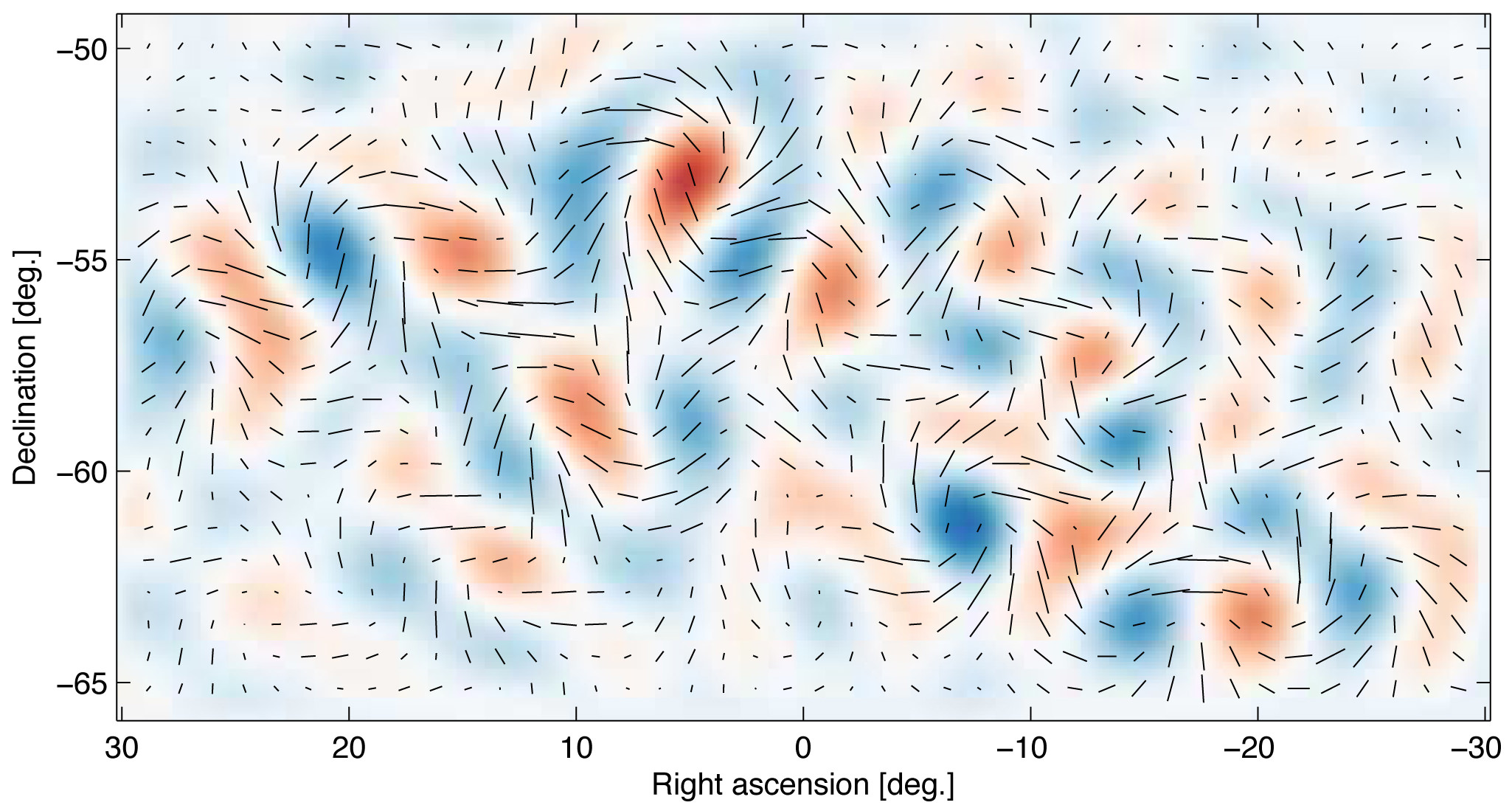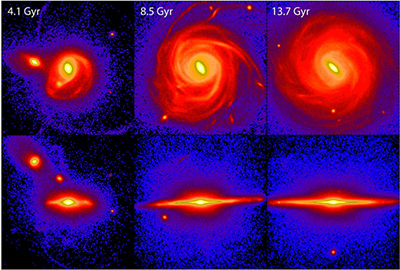A newly released documentary brings you behind the scenes in the hunt for gravitational waves. The 20-minute film, called “LIGO, A Passion for Understanding,” follows the scientists working to create one of the most powerful scientific tools ever made: the Laser Interferometer Gravitational-Wave Observatories (LIGO). You can watch the documentary above.
Continue reading “Watch: New Documentary Follows the Hunt for Gravitational Waves”
Watch Live Webcast: Secrets of the Universe’s First Light
Just a month ago came the news of the first direct evidence of primordial gravitational waves — ripples in the fabric of spacetime — providing the first direct evidence the Universe underwent a brief but stupendously accelerated expansion immediately following the Big Bang.
This almost unimaginably fast expansion when the Universe was only a trillionth of a trillionth of a trillionth of a second was first theorized more than three decades ago, and the announcement last month was so monumental that some are comparing it to the discovery of the Higgs boson.
On April 18, 20:00 UTC (3 pm EDT, 1:00 pm PDT, two of the scientists who made this groundbreaking discovery will come together for a conversation with two of the pioneering leaders of the field. Together, they will examine the detection of a distinctive, swirling pattern in the universe’s first light, what the swirl tells us about that monumental growth spurt, and the many implications on the way we understand the universe around us.
You can watch below:
The hangout will include members of the BICEP2, which made the discovery, as well as two notable scientists in this field, John Carlstrom and Michael Turner.
We’ve Discovered Inflation! Now What?
Days like these make being an astrophysicist interesting. On the one hand, there is the annoucement of BICEP2 that the long-suspected theory of an inflationary big bang is actually true. It’s the type of discovery that makes you want to grab random people off the street and tell them what an amazing thing the Universe is. On the other hand, this is exactly the type of moment when we should be calm, and push back on the claims made by one research team. So let’s take a deep breath and look at what we know, and what we don’t.

First off, let’s dispel a few rumors. This latest research is not the first evidence of gravitational waves. The first indirect evidence for gravitational waves was found in the orbital decay of a binary pulsar by Russell Hulse and Joseph Taylor, for which they were awarded the Nobel prize in 1993. This new work is also not the first discovery of polarization within the cosmic microwave background, or even the first observation of B-mode polarization. This new work is exciting because it finds evidence of a specific form of B-mode polarization due to primordial gravitational waves. The type of gravitational waves that would only be caused by inflation during the earliest moments of the Universe.
It should also be noted that this new work hasn’t yet been peer reviewed. It will be, and it will most likely pass muster, but until it does we should be a bit cautious about the results. Even then these results will need to be verified by other experiments. For example, data from the Planck space telescope should be able to confirm these results assuming they’re valid.
That said, these new results are really, really interesting.

What the team did was to analyze what is known as B-mode polarization within the cosmic microwave background (CMB). Light waves oscillate perpendicular to their direction of motion, similar to the way water waves oscillate up and down while they travel along the surface of water. This means light can have an orientation. For light from the CMB, this orientation has two modes, known as E and B. The E-mode polarization is caused by temperature fluctuations in the CMB, and was first observed in 2002 by the DASI interferometer.
The B-mode polarization can occur in two ways. The first way is due to gravitational lensing. The first is due to gravitational lensing of the E-mode. The cosmic microwave background we see today has travelled for more than 13 billion years before reaching us. Along its journey some of it has passed close enough to galaxies and the like to be gravitationally lensed. This gravitational lensing twists the polarization a bit, giving some of it a B-mode polarization. This type was first observed in July of 2013. The second way is due to gravitational waves from the early inflationary period of the universe. As inflationary period occurred, then it produced gravitational waves on a cosmic scale. Just as the gravitational lensing produces B-mode polarization, these primordial gravitational waves produce a B-mode effect. The discovery of primordial wave B-mode polarization is what was announced today.
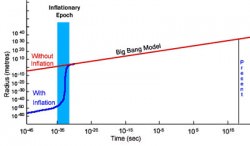
Inflation has been proposed as a reason for why the cosmic microwave background is as uniform as it is. We see small fluctuations in the CMB, but not large hot or cold spots. This means the early Universe must have been small enough for temperatures to even out. But the CMB is so uniform that the observable universe must have been much smaller than predicted by the big bang. However, if the Universe experienced a rapid increase in size during its early moments, then everything would work out. The only problem was we didn’t have any direct evidence of inflation.
Assuming these new results hold up, now we do. Not only that, we know that inflation was stronger than we anticipated. The strength of the gravitational waves is measured in a value known as r, where larger is stronger. It was found that r = 0.2, which is much higher than anticipated. Based upon earlier results from the Planck telescope, it was expected that r < 0.11. So there seems to be a bit of tension with earlier findings. There are ways in which this tension can be resolved, but just how is yet to be determined.
So this work still needs to be peer reviewed, and it needs to be confirmed by other experiments, and then the tension between this result and earlier results needs to be resolved. There is still much to do before we really understand inflation. But overall this is really big news, possibly even Nobel prize worthy. The results are so strong that it seems pretty clear we have direct evidence of cosmic inflation, which is a huge step forward. Before today we only had physical evidence back to when the universe was about a second old, at a time when nucleosynthesis occurred. With this new result we are now able to probe the Universe when it was less than 10 trillion trillion trillionths of a second old.
Which is pretty amazing when you think about it.
That Moment When the “Father of Inflation” Learns of the Detection of Gravitational Waves
Andrei Linde, a professor in the Department of Physics at Stanford University, is one of the main authors of the inflationary universe theory, that the universe underwent a brief but remarkably accelerated expansion immediately following the Big Bang.
Today, scientists announced that they’ve found direct evidence of primordial gravitational waves, which would provide a “smoking gun” for inflation, and also tell us when inflation took place and how powerful the process was.
Above is a scientifically heartwarming video of Linde being told of the gravitational wave discovery by Chao-Lin Kuo, also from Stanford University, the designer of the BICEP2 detector that made the discovery.
Landmark Discovery: New Results Provide Direct Evidence for Cosmic Inflation
Astronomers have announced Nobel Prize-worthy evidence of primordial gravitational waves — ripples in the fabric of spacetime — providing the first direct evidence the universe underwent a brief but stupendously accelerated expansion immediately following the big bang.
BICEP2 (Background Imaging of Cosmic Extragalactic Polarization) scans the sky from the south pole, looking for a subtle effect in the cosmic microwave background (CMB) — the radiation released 380,000 years after the Big Bang when the universe cooled enough to allow photons to travel freely across the cosmos.
The CMB fills every cubic centimeter of the observable universe with approximately 400 microwave photons. The so-called afterglow of the big bang is nearly uniform in all directions, but small residual variations (on the level of one in 100,000) in temperature show a specific pattern. These irregularities match what would be expected if minute quantum fluctuations had ballooned to the size of the observable universe today.
So astronomers dreamed up the theory of inflation — the epoch immediately following the big bang (10-34 seconds later) when the universe expanded exponentially (by at least a factor of 1025) — causing quantum fluctuations to magnify to cosmic size. Not only does inflation help explain why the universe is so smooth on such massive scales, but also why it’s flat when there’s an infinite number of other possible curvatures.
While inflation is a pillar of big bang cosmology, it has remained purely a theoretical framework. Many astronomers don’t buy it as we can’t explain what physical mechanism would have driven such a massive expansion, let alone stop it. The results announced today provide a strong case in support of inflation.
In Depth: We’ve Discovered Inflation! Now What?
The trick is in looking at the CMB where inflation’s signature is imprinted as incredibly faint patterns of polarized light — some of the light waves have a preferred plane of vibration. If a gravitational wave passes through the fabric of spacetime it will squeeze spacetime in one direction (making it hotter) and stretch it in another (making it cooler). Inflation will then amplify these quantum fluctuations into a detectable signal: the hotter and therefore more energetic photons will be visible in the CMB, leaving a slight polarization imprint.

This effect will create two distinct patterns: E-modes and B-modes, which are differentiated based on whether or not they have even or odd parity. In simpler terms: E-mode patterns will look the same when reflected in a mirror, whereas B-mode patterns will not.
E-modes have already been extensively detected and studied. While both are the result of primordial gravitational waves, E-modes can be produced through multiple mechanisms whereas B-modes can only be produced via primordial gravitational waves. Detecting the latter is a clean diagnostic — or as astronomers are putting it: “smoking gun evidence” — of inflation, which amplified gravitational waves in the early Universe.
“The swirly B-mode pattern is a unique signature of gravitational waves because of their handedness. This is the first direct image of gravitational waves across the primordial sky,” said co-leader Chao-Lin Kuo from Stanford University, designer of the BICEP2 detector.
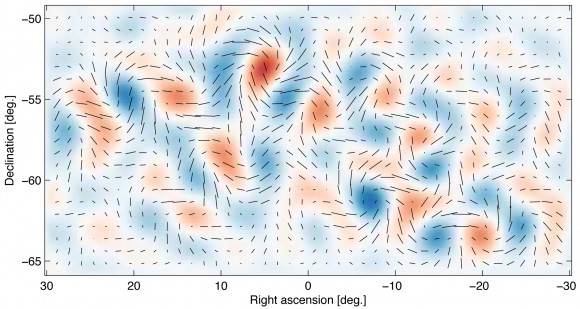
The team analyzed sections of the sky spanning one to five degrees (two to 10 times the size of the full moon) for more than three years. They created a unique array of 512 detectors, which collectively operate at a frosty 0.25 Kelvin. This new technology enabled them to make detections at a speed 10 times faster than before.
The results are surprisingly robust, with a 5.9 sigma detection. For comparison, when particle physicists announced the discovery of the Higgs Boson in July, 2012 they had to reach at least a 5 sigma result, or a confidence level of 99.9999 percent. At this level, the chance that the result is erroneous due to random statistical fluctuations is only one in a million. Those are pretty good odds.
While the team was careful to rule out any errors, it will be crucial for another team to verify these results. The Planck spacecraft, which has been producing exquisite measurements of the CMB, will be reporting its own findings later this year. At least a dozen other teams have also been searching for this signature.
“This work offers new insights into some of our most basic questions: Why do we exist? How did the universe begin?” commented Harvard theorist Avi Loeb. “These results are not only a smoking gun for inflation, they also tell us when inflation took place and how powerful the process was.”
Not only does inflation succeed in explaining the origin of cosmic structure — how the cosmic web formed from the smooth aftermath of the big bang — but it makes wilder predictions as well. The model seems to produce not just one universe, but rather an ensemble of universes, otherwise known as a multiverse. This collection of universes has no end and no beginning, continuing to pop up eternally.
Today’s results provide a stronger case for “eternal inflation,” which gives a new perspective on our desolate place within the cosmos. Not only do we live on a small planet orbiting one star out of hundreds of billions, in one galaxy out of hundreds of billions, but our entire universe may just be one bubble out of a vast cosmic ocean of others.
The detailed paper may be found here.
The full set of papers are here.
An FAQ summarizing the data is here.
Does Free Will Exist? Ancient Quasars May Hold the Clue.
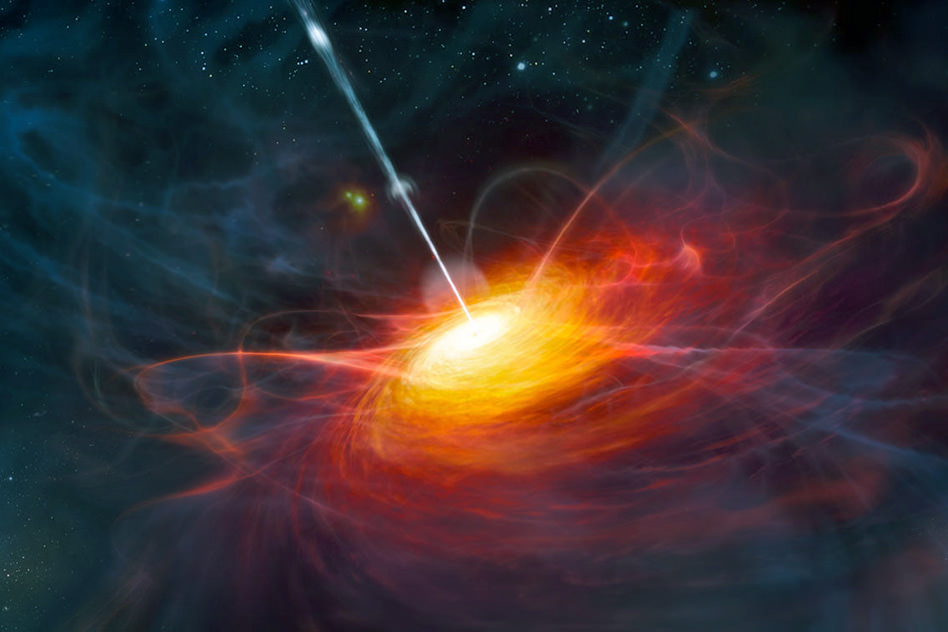
Do you believe in free will? Are people able to decide their own destinies, whether it’s on what continent they’ll live, who or if they’ll marry, or just where they’ll get lunch today? Or are we just the unwitting pawns of some greater cosmic mechanism at work, ticking away the seconds and steering everyone and everything toward an inevitable, predetermined fate?
Philosophical debates aside, MIT researchers are actually looking to move past this age-old argument in their experiments once and for all, using some of the most distant and brilliant objects in the Universe.
Rather than ponder the ancient musings of Plato and Aristotle, researchers at MIT were trying to determine how to get past a more recent conundrum in physics: Bell’s Theorem. Proposed by Irish physicist John Bell in 1964, the principle attempts to come to terms with the behavior of “entangled” quantum particles separated by great distances but somehow affected simultaneously and instantaneously by the measurement of one or the other — previously referred to by Einstein as “spooky action at a distance.”
The problem with such spookiness in the quantum universe is that it seems to violate some very basic tenets of what we know about the macroscopic universe, such as information traveling faster than light. (A big no-no in physics.)
(Note: actual information is not transferred via quantum entanglement, but rather it’s the transfer of state between particles that can occur at thousands of times the speed of light.)
Read more: Spooky Experiment on ISS Could Pioneer New Quantum Communications Network
Then again, testing against Bell’s Theorem has resulted in its own weirdness (even as quantum research goes.) While some of the intrinsic “loopholes” in Bell’s Theorem have been sealed up, one odd suggestion remains on the table: what if a quantum-induced absence of free will (i.e., hidden variables) is conspiring to affect how researchers calibrate their detectors and collect data, somehow steering them toward a conclusion biased against classical physics?
“It sounds creepy, but people realized that’s a logical possibility that hasn’t been closed yet,” said David Kaiser, Germeshausen Professor of the History of Science and senior lecturer in the Department of Physics at MIT in Cambridge, Mass. “Before we make the leap to say the equations of quantum theory tell us the world is inescapably crazy and bizarre, have we closed every conceivable logical loophole, even if they may not seem plausible in the world we know today?”
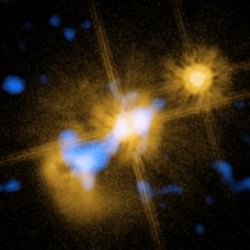
So in order to clear the air of any possible predestination by entangled interlopers, Kaiser and MIT postdoc Andrew Friedman, along with Jason Gallicchio of the University of Chicago, propose to look into the distant, early Universe for sufficiently unprejudiced parties: ancient quasars that have never, ever been in contact.
According to a news release from MIT:
…an experiment would go something like this: A laboratory setup would consist of a particle generator, such as a radioactive atom that spits out pairs of entangled particles. One detector measures a property of particle A, while another detector does the same for particle B. A split second after the particles are generated, but just before the detectors are set, scientists would use telescopic observations of distant quasars to determine which properties each detector will measure of a respective particle. In other words, quasar A determines the settings to detect particle A, and quasar B sets the detector for particle B.
By using the light from objects that came into existence just shortly after the Big Bang to calibrate their detectors, the team hopes to remove any possibility of entanglement… and determine what’s really in charge of the Universe.
“I think it’s fair to say this is the final frontier, logically speaking, that stands between this enormously impressive accumulated experimental evidence and the interpretation of that evidence saying the world is governed by quantum mechanics,” said Kaiser.
Then again, perhaps that’s exactly what they’re supposed to do…
The paper was published this week in the journal Physical Review Letters.
Source: MIT Media Relations
Want to read more about the admittedly complex subject of entanglement and hidden variables (which may or may not really have anything to do with where you eat lunch?) Click here.
NOvA Experiment Nabs Its First Neutrinos
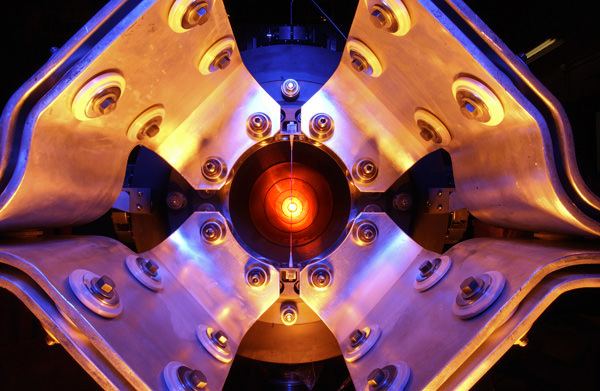
Neutrinos are some of the most abundant, curious, and elusive critters in particle physics. Incredibly lightweight — nigh massless, according to the Standard Model — as well as chargeless, they zip around the Universe at the speed of light and they don’t interact with any other particles. Some of them have been around since the Big Bang and, just as you’ve read this, trillions of them have passed through your body (and more are on the way.) But despite their ubiquitousness neutrinos are notoriously difficult to study precisely because they ignore pretty much everything made out of anything else. So it’s not surprising that weighing a neutrino isn’t as simple as politely asking one to step on a scale.
Thankfully particle physicists are a tenacious lot, including the ones at the U.S. Department of Energy’s Fermilab, and they aren’t giving up on their latest neutrino safari: the NuMI Off-Axis Electron Neutrino Appearance experiment, or NOvA. (Scientists represent neutrinos with the Greek letter nu, or v.) It’s a very small-game hunt to catch neutrinos on the fly, and it uses some very big equipment to do the job. And it’s already captured its first neutrinos — even before their setup is fully complete.
Created by smashing protons against graphite targets in Fermilab’s facility just outside Chicago, Illinois, resulting neutrinos are collected and shot out in a beam 500 miles northwest to the NOvA far detector in Ash River, Minnesota, located along the Canadian border. The very first beams were fired in Sept. 2013, while the Ash River facility was still under construction.

“That the first neutrinos have been detected even before the NOvA far detector installation is complete is a real tribute to everyone involved,” said University of Minnesota physicist Marvin Marshak, Ash River Laboratory director. “This early result suggests that the NOvA collaboration will make important contributions to our knowledge of these particles in the not so distant future.”

The beams from Fermilab are fired in two-second intervals, each sending billions of neutrinos directly toward the detectors. The near detector at Fermilab confirms the initial “flavor” of neutrinos in the beam, and the much larger far detector then determines if the neutrinos have changed during their three-millisecond underground interstate journey.
Again, because neutrinos don’t readily interact with ordinary particles, the beams can easily travel straight through the ground between the facilities — despite the curvature of the Earth. In fact the beam, which starts out 150 feet (45 meters) below ground near Chicago, eventually passes over 6 miles (10 km) deep during its trip.
According to a press release from Fermilab, neutrinos “come in three types, called flavors (electron, muon, or tau), and change between them as they travel. The two detectors of the NOvA experiment are placed so far apart to give the neutrinos the time to oscillate from one flavor to another while traveling at nearly the speed of light. Even though only a fraction of the experiment’s larger detector, called the far detector, is fully built, filled with scintillator and wired with electronics at this point, the experiment has already used it to record signals from its first neutrinos.”
The 50-foot (15 m) tall detector blocks are filled with a liquid scintillator that’s made of 95% mineral oil and 5% liquid hydrocarbon called pseudocumene, which is toxic but “imperative to the neutrino-detecting process.” The mixture magnifies any light that hits it, allowing the neutrino strikes to be more easily detected and measured. (Source)
“NOvA represents a new generation of neutrino experiments,” said Fermilab Director Nigel Lockyer. “We are proud to reach this important milestone on our way to learning more about these fundamental particles.”
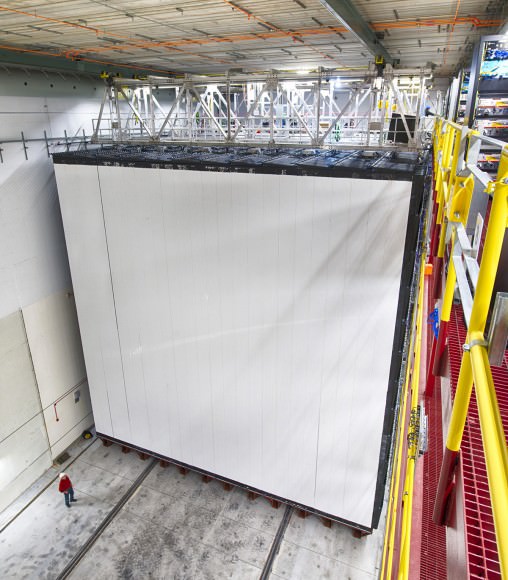
After completion this summer NOvA’s near and far detectors will weigh 300 and 14,000 tons, respectively.
The goal of the NOvA experiment is to successfully capture and measure the masses of the different neutrino flavors and also determine if neutrinos are their own antiparticles (they could be the same, since they lack specific charge.) By comparing the oscillations (i.e., flavor changes) of muon neutrino beams vs. muon antineutrino beams fired from Fermilab, scientists hope to determine their mass hierarchy — and ultimately discover why the Universe currently contains much more matter than antimatter.
Read more: Neutrino Detection Could Help Paint an Entirely New Picture of the Universe
Once the experiment is fully operational scientists expect to catch a precious few neutrinos every day — about 5,000 total over the course of its six-year run. Until then, they at least now have their first few on the books.
“Seeing neutrinos in the first modules of the detector in Minnesota is a major milestone. Now we can start doing physics.”
– Rick Tesarek, Fermilab physicist
Learn more about the development and construction of the NoVA experiment below:
(Video credit: Fermilab)
Find out more about the NOvA research goals here.
Source: Fermilab press release
The NOvA collaboration is made up of 208 scientists from 38 institutions in the United States, Brazil, the Czech Republic, Greece, India, Russia and the United Kingdom. The experiment receives funding from the U.S. Department of Energy, the National Science Foundation and other funding agencies.
Milky Way Shakes, Rattles and Rolls…
For decades astronomers have puzzled over the many details concerning the formation of the Milky Way Galaxy. Now a group of scientists headed by Ivan Minchev from the Leibniz Institute for Astrophysics Potsdam (AIP) have managed to retrace our galaxy’s formative periods with more detail than ever before. This newly published information has been gathered through careful observation of stars located near the Sun and points to a rather “moving” history.
To achieve these latest results, astronomers observed stars perpendicular to the galactic disc and their vertical motion. Just to shake things up, these stars also had their ages considered. Because it is nearly impossible to directly determine a star’s true age, they rattled the cage of chemical composition. Stars which show an increase in the ratio of magnesium to iron ([Mg/Fe]) appear to have a greater age. These determinations of stars close to the Sun were made with highly accurate information gathered by the RAdial Velocity Experiment (RAVE). According to previous findings, “the older a star is, the faster it moves up and down through the disc”. This no longer seemed to be true. Apparently the rules were broken by stars with the highest magnesium-to-iron ratios. Despite what astronomers thought would happen, they observed these particular stars slowing their roll… their vertical speed decreasing dramatically.
So what’s going on here? To help figure out these curious findings, the researchers turned to computer modeling. By running a simulation of the Milky Way’s evolutionary patterns, they were able to discern the origin of these older, slower stars. According to the simulation, they came to the conclusion that small galactic collisions might be responsible for the results they had directly observed.
Smashing into, or combining with, a smaller galaxy isn’t new to the Milky Way. It is widely accepted that our galaxy has been the receptor of galactic collisions many times during its course of history. Despite what might appear to be a very violent event, these incidents aren’t very good at shaking up the massive regions near the galactic center. However, they stir things up in the spiral arms! Here star formation is triggered and these stars move away from the core towards our galaxy’s outer edge – and near our Sun.
In a process known as “radial migration”, older stars, ones with high values of magnesium-to-iron ratio, are pushed outward and display low up-and-down velocities. Is this why the elderly, near-by stars have diminished vertical velocities? Were they forced from the galactic center by virtue of a collision event? Astronomers speculate this to be the best answer. By comparison, the differences in speed between stars born near the Sun and those forced away shows just how massive and how many merging galaxies once shook up the Milky Way.
Says AIP scientist Ivan Minchev: “Our results will enable us to trace the history of our home galaxy more accurately than ever before. By looking at the chemical composition of stars around us, and how fast they move, we can deduce the properties of satellite galaxies interacting with the Milky Way throughout its lifetime. This can lead to an improved understanding of how the Milky Way may have evolved into the galaxy we see today.”
Original Story Source: Leibniz Institute for Astrophysics Potsdam News Release. For further reading: A new stellar chemo-kinematic relation reveals the merger history of the Milky Way.
New Online Classes to Help You Learn More about the Universe

Roughly eighty percent of all the mass in the Universe is made of dark matter – a mysterious invisible substance responsible for the structure of galaxies and the patterns of the cosmos on the very largest scales. But how do we know that?
Astronomical images are beautiful, but that’s not their primary purpose from a scientist’s point of view. How can we take those images and infer things about what they are?
We only know of one planet harboring life: Earth. But that doesn’t mean we don’t know anything about the possibility of life elsewhere in the cosmos. How can we infer things about possible alien organisms when we can’t see them (yet)?
 If you’re curious about those and other classes, CosmoAcademy — a project from the CosmoQuest educational and citizen-science group — could be for you. We’re offering three new online classes: Introduction to Dark Matter, Introduction to Astronomy via Color Imaging, and Life Beyond Earth: Introduction to Astrobiology.
If you’re curious about those and other classes, CosmoAcademy — a project from the CosmoQuest educational and citizen-science group — could be for you. We’re offering three new online classes: Introduction to Dark Matter, Introduction to Astronomy via Color Imaging, and Life Beyond Earth: Introduction to Astrobiology.
These classes are short, four-hour courses designed for curious but busy people. All CosmoAcademy classes are offered online through Google+ Hangouts, a type of video chat. Part of the reason we do that is to limit the size of courses to eight students. That allows us to provide individual instruction in a way no other kind of online class is able to do – you aren’t a faceless student, but part of every discussion. In fact, if there’s a topic you want to discuss, there’s a good chance your instructor will take the time to talk about it.
Interested? See our course listings, and please let me know if you have any questions. Here are a few more details:
CQX015: Introduction to Dark Matter
Roughly eighty percent of all the mass in the Universe is made of dark matter – a mysterious invisible substance responsible for the structure of galaxies. But how do we know that? In this course, we’ll examine the evidence in favor of dark matter’s existence, from the rotation of galaxies to the radiation left over from the infancy of the cosmos. After that, we’ll examine what we can infer about the identity of dark matter and sketch out some of the experiments designed to detect it. This class assumes no background except a strong interest in astronomy and cosmology.
Instructor: Matthew Francis
Course structure: Two weeks, four 60-minute meetings
Meeting times: Tuesdays and Thursdays, 9–10 PM US Eastern time (6-7 PM US Pacific time)
Course dates: January 28—February 6, 2014
CQX021: Introduction to Astronomy Via Color Imaging
When astronomers look at a star, nebula or galaxy for the first time, they see some unreachably distant object acting in some unknown way. What does it have to be made of and how does it have to be acting to look like that? In this class we will be looking at how we use the visual appearance of astronomical objects to figure out what they are. We will examine this problem by making our own color images from the sources provided by observatories from real research projects. From the subtle hues of stars in a distant galaxy to the eerie neon colors of nebulae to the chaotic Sun, by looking at objects in the right light, we can find out what makes them tick.
Instructor: Peter Dove
Course structure: Two weeks, four 60-minute meetings
Meeting times: Tuesdays and Thursdays, 8–9 PM US Eastern time (5-6 PM US Pacific time)
Course dates: Tuesday, February 25—Thursday, March 6
CQX013 – Astrobiology: Life in the Universe
What will it take to find extraterrestrial life? Frank Drake penned his famous “equation” to determine the instances of life in the Galaxy over 50 years ago. Meant more as a discussion guideline than a rigorous mathematical formula, it will guide our discussion on the science of astronomy, biology, and astrobiology as we consider the possibility of life in the Universe.
Instructor: Nicole Gugliucci
Course structure: Two weeks, four 60-minute meetings
Meeting times: Mondays and Thursdays, 9–10 PM US Eastern time (6-7 PM US Pacific time)
Course dates: Monday, March 17 — Thursday, March 27
One Percent Measure of the Universe
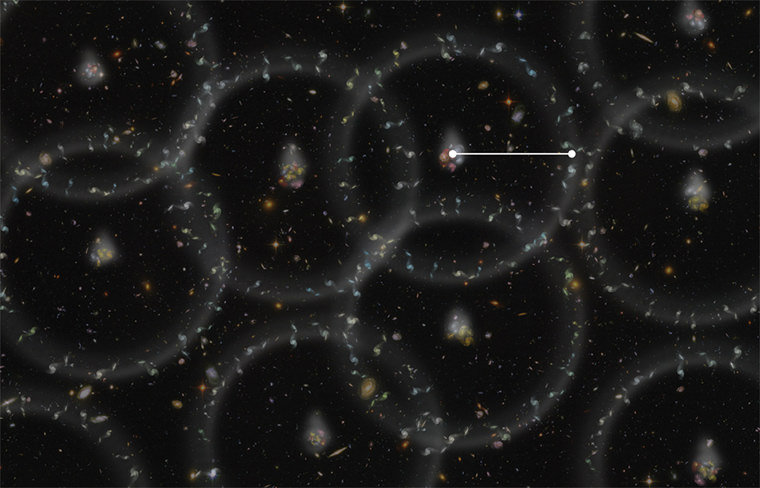
When it comes to accuracy, everyone strives for a hundred percent, but measuring cosmic distances leaves a bit more to chance. Just days ago, researchers from the Baryon Oscillation Spectroscopic Survey (BOSS) announced to the world that they have been able to measure the distance to galaxies located more than six billion light-years away to a confidence level of just one percent. If this announcement doesn’t seem exciting, then think on what it means to other studies. These new measurements give a parameter to the properties of the ubiquitous “dark energy” – the source of universal expansion.
“There are not many things in our daily lives that we know to one-percent accuracy,” said David Schlegel, a physicist at Lawrence Berkeley National Laboratory (LBNL) and the principal investigator of BOSS. “I now know the size of the universe better than I know the size of my house.”
The research team’s findings were presented at the meeting of the American Astronomical Society by Harvard University astronomer Daniel Eisenstein, the director of the Sloan Digital Sky Survey III (SDSS-III), the worldwide organization which includes BOSS. They are detailed in a series of articles submitted to journals by the BOSS collaboration last month, all of which are now available as online preprints.
“Determining distance is a fundamental challenge of astronomy,” said Eisenstein. “You see something in the sky — how far away is it? Once you know how far away it is, learning everything else about it is suddenly much easier.”
When it comes to measuring distances in space, astronomers have employed many methods. To measure distances to planets has been accomplished using radar, but it has its constraints and going further into space means a less direct method. Even though they have been proved to be amazingly accurate, there is still an uncertainty factor involved – one that is expressed as a percentage. For example, if you were to measure the distance from an object 200 miles away to within a true value of 2 miles, then you have measured with an accuracy of 1%. Cosmically speaking, just a few hundred stars and a handful of star clusters are actually close enough to have their distances so accurately predicted. They reside within the Milky Way and are just a few thousand light-years away. BOSS takes it to the extreme… its measurements go well beyond our galactic boundaries, more than a million times further, and maps the Universe with unparalleled accuracy.
Thanks to these new, highly-accurate distance measurements, BOSS astronomers are making headway in the field of dark energy. “We don’t yet understand what dark energy is,” explained Eisenstein, “but we can measure its properties. Then, we compare those values to what we expect them to be, given our current understanding of the universe. The better our measurements, the more we can learn.”
Just how is it done? To achieve a one-percent measurement at six billion light years isn’t as easy as measuring a solar system object, or even one contained within our galaxy. That’s where the BOSS comes into play. It’s the largest of the four projects that make up the Sloan Digital Sky Survey III (SDSS-III), and was built to take advantage of this technique: measuring the so-called “baryon acoustic oscillations” (BAOs), subtle periodic ripples in the distribution of galaxies in the cosmos. These ripples are the signature of pressure waves which once cruised the early Universe at a time when things were so hot and dense that photons marched along with baryons – the stuff which creates the nuclei of atoms. Since the size of the ripple is known, that size can now be measured by mapping galaxies.
“With these galaxy measurements, nature has given us a beautiful ruler,” said Ashley Ross, an astronomer from the University of Portsmouth. “The ruler happens to be half a billion light-years long, so we can use it to measure distances precisely, even from very far away.
Using its specialized instrumentation which can make detailed measurements of a thousand galaxies at a time, BOSS took on a huge challenge – mapping the location of more than a million galaxies. “On a clear night when everything goes perfectly, we can add more than 8000 galaxies and quasars to the map,” said Kaike Pan, who leads the team of observers at the SDSS-III’s Sloan Foundation 2.5-meter Telescope at Apache Point Observatory in New Mexico.
Although the BOSS research team presented its early galaxy maps and beginning BAO measurements a year ago, this new data covers twice as much territory and gives an even more accurate measurement – including those to nearby galaxies. “Making these measurements at two different distances allows us to see how the expansion of the universe has changed over time, which will help us understand why it is accelerating,” explained University of Portsmouth astronomer Rita Tojeiro, who co-chairs the BOSS galaxy clustering working group along with Jeremy Tinker of New York University.
Also doing a similar study is Mariana Vargas-Magana, a postdoctoral researcher at Carnegie Mellon University. To enable even more accuracy, she’s looking into any subtle effects which could influence the BOSS measurements. “When you’re trying to reach one percent, you have to be paranoid about everything that could go even slightly wrong,” said Vargas-Magana — for example, slight differences in how galaxies were identified could have thrown off the entire measurement of their distribution, so different parts of the sky had to be checked carefully. “Fortunately,” Vargas-Magana said, “there are plenty of careful people on our team to check our assumptions. By the time all of them are satisfied, we are sure we didn’t miss anything.”
As of the present, these new BOSS findings would seem to be consistent with what we consider to be form of dark energy – a constant found throughout the history of the Universe. According to the news release, this “cosmological constant” is one of just six numbers required to create a model which coincides with the scale and structure of the Universe. Schlegel compares this six-number model to a pane of glass, which is pinned in place by bolts that represent different measurements of the history of the Universe. “BOSS now has one of the tightest of those bolts, and we just gave it another half-turn,” said Schlegel. “Each time you ratchet up the tension and the glass doesn’t break, that’s a success of the model.”
Original Story Source: Sloan Digital Sky Survey III News Release. For further reading: Max Planck Institute News Release.


